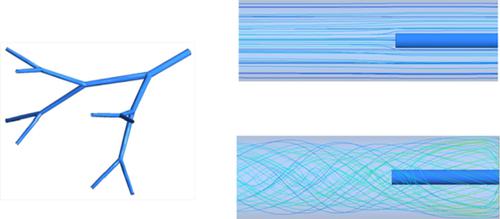当前位置:
X-MOL 学术
›
Int. J. Numer. Method. Biomed. Eng.
›
论文详情
Our official English website, www.x-mol.net, welcomes your feedback! (Note: you will need to create a separate account there.)
On the importance of spiral-flow inflow boundary conditions when using idealized artery geometries in the analysis of liver radioembolization: A parametric study.
International Journal for Numerical Methods in Biomedical Engineering ( IF 2.1 ) Pub Date : 2020-04-17 , DOI: 10.1002/cnm.3337 Julio Ortega 1, 2 , Raul Antón 2, 3 , Juan C Ramos 2 , Alejandro Rivas 2 , Gorka S Larraona 2 , Bruno Sangro 3, 4 , Jose I Bilbao 3, 4 , Jorge Aramburu 2
International Journal for Numerical Methods in Biomedical Engineering ( IF 2.1 ) Pub Date : 2020-04-17 , DOI: 10.1002/cnm.3337 Julio Ortega 1, 2 , Raul Antón 2, 3 , Juan C Ramos 2 , Alejandro Rivas 2 , Gorka S Larraona 2 , Bruno Sangro 3, 4 , Jose I Bilbao 3, 4 , Jorge Aramburu 2
Affiliation

|
In the last decades, the numerical studies on hemodynamics have become a valuable explorative scientific tool. The very first studies were done over idealized geometries, but as numerical methods and the power of computers have become more affordable, the studies tend to be patient specific. We apply the study to the numerical analysis of tumor‐targeting during liver radioembolization (RE). RE is a treatment for liver cancer, and is performed by injecting radiolabeled microspheres via a catheter placed in the hepatic artery. The objective of the procedure is to maximize the release of radiolabeled microspheres into the tumor and avoid a healthy tissue damage. Idealized virtual arteries can serve as a generalist approach that permits to separately analyze the effect of a variable in the microsphere distribution with respect to others. However, it is important to use proper physiological boundary conditions (BCs). It is not obvious, the need to account for the effect of tortuosity when using an idealized virtual artery. We study the use of idealized geometry of a hepatic artery as a valid research tool, exploring the importance of using realistic spiral‐flow inflow BC. By using a literature‐based cancer scenario, we vary two parameters to analyze the microsphere distribution through the outlets of the geometry. The parameters varied are the type of microspheres injected and the microsphere injection velocity. The results with realistic inlet velocity profile showed that the particle distribution in the liver segments is not affected by the analyzed injection velocity values neither by the particle density.
中文翻译:

关于理想化的动脉几何形状在肝放射性栓塞分析中使用螺旋流流入边界条件的重要性:一项参数研究。
在过去的几十年中,关于血液动力学的数值研究已成为一种有价值的探索性科学工具。最初的研究是针对理想的几何形状进行的,但是随着数值方法和计算机功能的日益普及,这些研究往往针对患者。我们将该研究应用于肝脏放射性栓塞(RE)期间靶向肿瘤的数值分析。RE是一种治疗肝癌的方法,可通过放置在肝动脉中的导管注射放射性标记的微球来进行。该程序的目的是最大程度地将放射性标记的微球释放到肿瘤中,并避免健康的组织损伤。理想的虚拟动脉可以用作通才的方法,该方法允许分别分析微球分布中变量相对于其他变量的影响。然而,重要的是要使用适当的生理边界条件(BCs)。使用理想的虚拟动脉时,需要考虑曲折的影响并不明显。我们研究了理想化的肝动脉几何结构作为有效的研究工具的使用,探讨了使用逼真的螺旋流入流BC的重要性。通过使用基于文献的癌症方案,我们改变了两个参数来分析通过几何体出口的微球分布。改变的参数是注入的微球的类型和注入微球的速度。具有实际入口速度曲线的结果表明,肝段中的颗粒分布不受分析的注射速度值的影响,也不受颗粒密度的影响。使用理想的虚拟动脉时,需要考虑曲折的影响并不明显。我们研究了理想化的肝动脉几何结构作为有效的研究工具的使用,探讨了使用逼真的螺旋流入流BC的重要性。通过使用基于文献的癌症方案,我们改变了两个参数来分析通过几何体出口的微球分布。改变的参数是注入的微球的类型和注入微球的速度。具有实际入口速度曲线的结果表明,肝段中的颗粒分布不受分析的注射速度值的影响,也不受颗粒密度的影响。使用理想的虚拟动脉时,需要考虑曲折的影响并不明显。我们研究了理想化的肝动脉几何结构作为有效的研究工具的使用,探讨了使用逼真的螺旋流入流BC的重要性。通过使用基于文献的癌症方案,我们改变了两个参数来分析通过几何体出口的微球分布。改变的参数是注入的微球的类型和注入微球的速度。具有实际入口速度曲线的结果表明,肝段中的颗粒分布不受分析的注射速度值的影响,也不受颗粒密度的影响。我们研究了理想化的肝动脉几何结构作为有效的研究工具的使用,探讨了使用逼真的螺旋流入流BC的重要性。通过使用基于文献的癌症方案,我们改变了两个参数来分析通过几何体出口的微球分布。改变的参数是注入的微球的类型和注入微球的速度。具有实际入口速度曲线的结果表明,肝段中的颗粒分布不受分析的注射速度值的影响,也不受颗粒密度的影响。我们研究了理想化的肝动脉几何结构作为有效的研究工具的使用,探讨了使用逼真的螺旋流入流BC的重要性。通过使用基于文献的癌症方案,我们改变了两个参数来分析通过几何体出口的微球分布。改变的参数是注入的微球的类型和注入微球的速度。具有实际入口速度曲线的结果表明,肝段中的颗粒分布不受分析的注射速度值的影响,也不受颗粒密度的影响。改变的参数是注入的微球的类型和注入微球的速度。具有实际入口速度曲线的结果表明,肝段中的颗粒分布不受分析的注射速度值的影响,也不受颗粒密度的影响。改变的参数是注入的微球的类型和注入微球的速度。具有实际入口速度曲线的结果表明,肝段中的颗粒分布不受分析的注射速度值的影响,也不受颗粒密度的影响。
更新日期:2020-04-17
中文翻译:

关于理想化的动脉几何形状在肝放射性栓塞分析中使用螺旋流流入边界条件的重要性:一项参数研究。
在过去的几十年中,关于血液动力学的数值研究已成为一种有价值的探索性科学工具。最初的研究是针对理想的几何形状进行的,但是随着数值方法和计算机功能的日益普及,这些研究往往针对患者。我们将该研究应用于肝脏放射性栓塞(RE)期间靶向肿瘤的数值分析。RE是一种治疗肝癌的方法,可通过放置在肝动脉中的导管注射放射性标记的微球来进行。该程序的目的是最大程度地将放射性标记的微球释放到肿瘤中,并避免健康的组织损伤。理想的虚拟动脉可以用作通才的方法,该方法允许分别分析微球分布中变量相对于其他变量的影响。然而,重要的是要使用适当的生理边界条件(BCs)。使用理想的虚拟动脉时,需要考虑曲折的影响并不明显。我们研究了理想化的肝动脉几何结构作为有效的研究工具的使用,探讨了使用逼真的螺旋流入流BC的重要性。通过使用基于文献的癌症方案,我们改变了两个参数来分析通过几何体出口的微球分布。改变的参数是注入的微球的类型和注入微球的速度。具有实际入口速度曲线的结果表明,肝段中的颗粒分布不受分析的注射速度值的影响,也不受颗粒密度的影响。使用理想的虚拟动脉时,需要考虑曲折的影响并不明显。我们研究了理想化的肝动脉几何结构作为有效的研究工具的使用,探讨了使用逼真的螺旋流入流BC的重要性。通过使用基于文献的癌症方案,我们改变了两个参数来分析通过几何体出口的微球分布。改变的参数是注入的微球的类型和注入微球的速度。具有实际入口速度曲线的结果表明,肝段中的颗粒分布不受分析的注射速度值的影响,也不受颗粒密度的影响。使用理想的虚拟动脉时,需要考虑曲折的影响并不明显。我们研究了理想化的肝动脉几何结构作为有效的研究工具的使用,探讨了使用逼真的螺旋流入流BC的重要性。通过使用基于文献的癌症方案,我们改变了两个参数来分析通过几何体出口的微球分布。改变的参数是注入的微球的类型和注入微球的速度。具有实际入口速度曲线的结果表明,肝段中的颗粒分布不受分析的注射速度值的影响,也不受颗粒密度的影响。我们研究了理想化的肝动脉几何结构作为有效的研究工具的使用,探讨了使用逼真的螺旋流入流BC的重要性。通过使用基于文献的癌症方案,我们改变了两个参数来分析通过几何体出口的微球分布。改变的参数是注入的微球的类型和注入微球的速度。具有实际入口速度曲线的结果表明,肝段中的颗粒分布不受分析的注射速度值的影响,也不受颗粒密度的影响。我们研究了理想化的肝动脉几何结构作为有效的研究工具的使用,探讨了使用逼真的螺旋流入流BC的重要性。通过使用基于文献的癌症方案,我们改变了两个参数来分析通过几何体出口的微球分布。改变的参数是注入的微球的类型和注入微球的速度。具有实际入口速度曲线的结果表明,肝段中的颗粒分布不受分析的注射速度值的影响,也不受颗粒密度的影响。改变的参数是注入的微球的类型和注入微球的速度。具有实际入口速度曲线的结果表明,肝段中的颗粒分布不受分析的注射速度值的影响,也不受颗粒密度的影响。改变的参数是注入的微球的类型和注入微球的速度。具有实际入口速度曲线的结果表明,肝段中的颗粒分布不受分析的注射速度值的影响,也不受颗粒密度的影响。


























 京公网安备 11010802027423号
京公网安备 11010802027423号